Cincinnati’s Modern Streetcar
Last month I visited Cleveland to check out the best Bus Rapid Transit (BRT) route in the country, see Cleveland’s Healthline Bus Rapid Transit (BRT), Part 4. Earlier this month I was back in Ohio, this time in Cincinnati.
During my 3-day visit for a Streetsblog meeting we checked out the upcoming Cincinnati Streetcar. Expected to be operational by the end of September 2016, the tracks, overhead wires, & platforms are all in place.
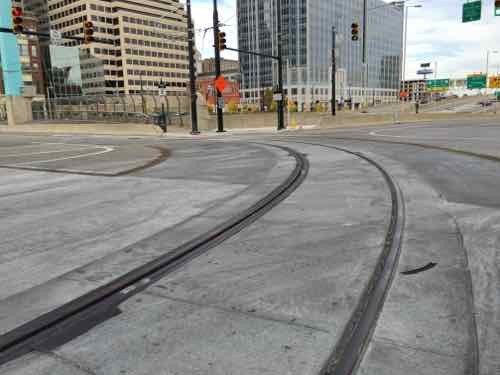
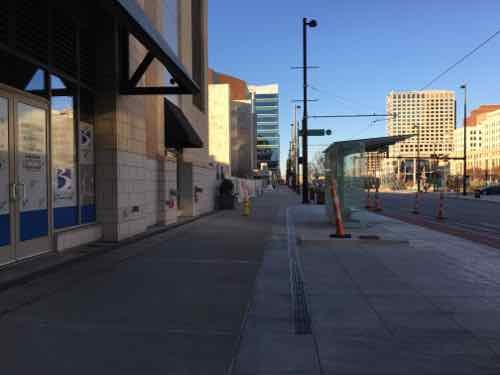
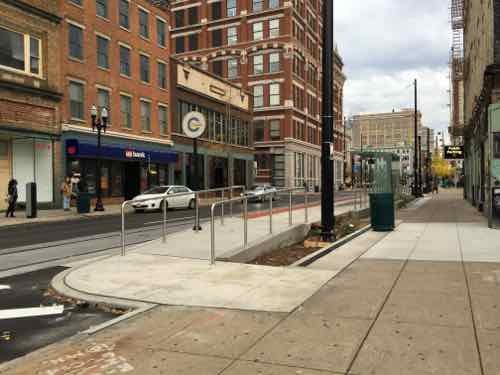
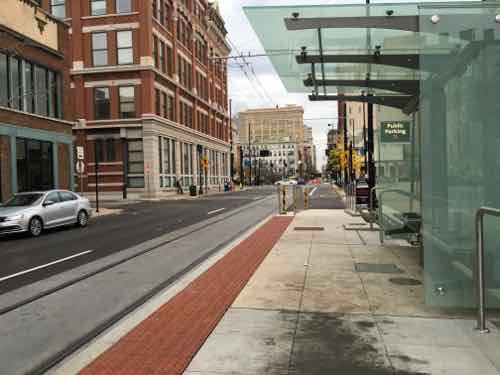
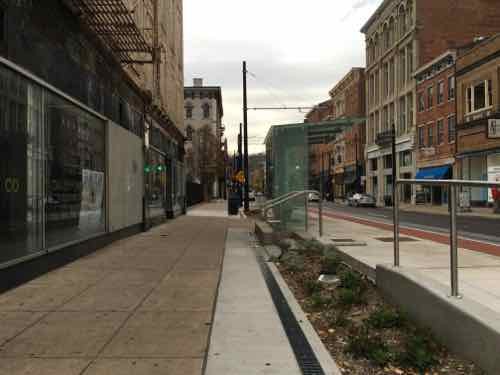
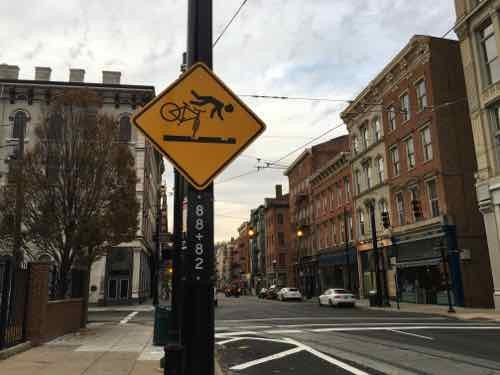
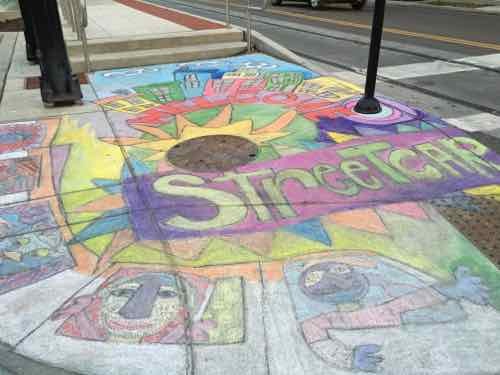
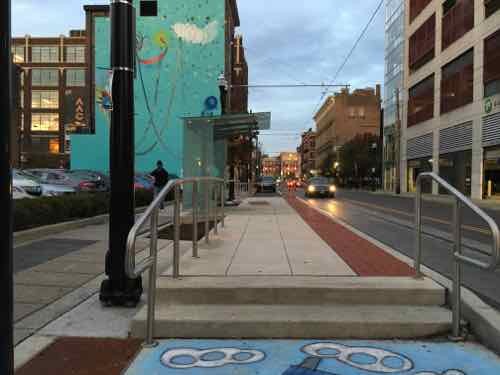
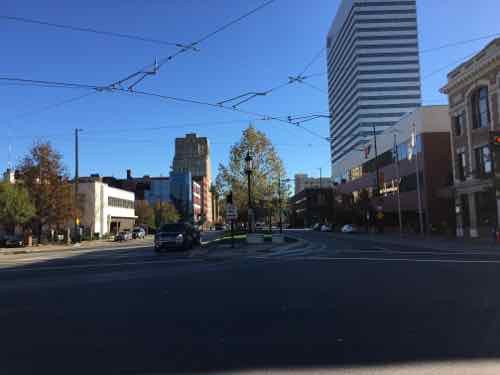
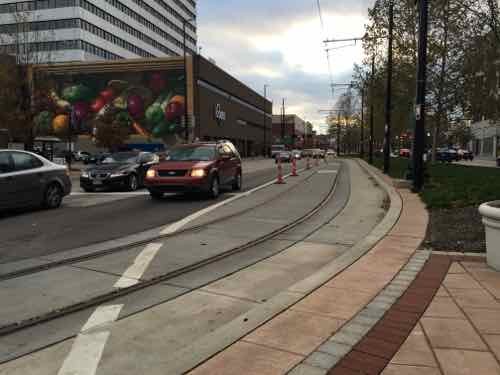
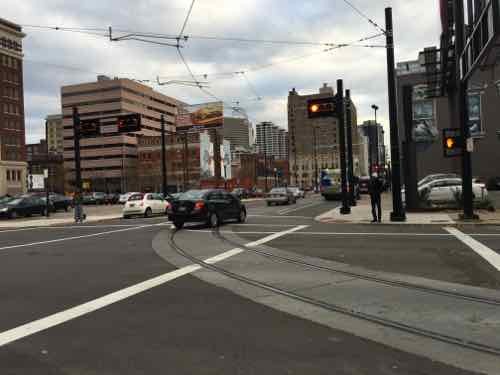
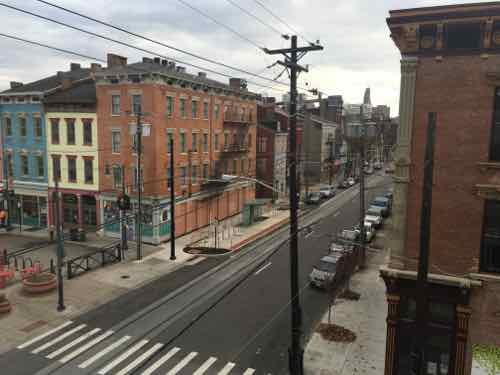
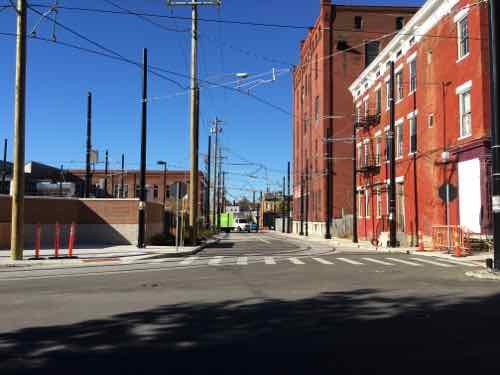
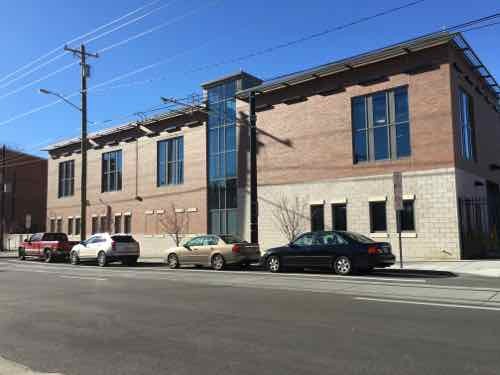
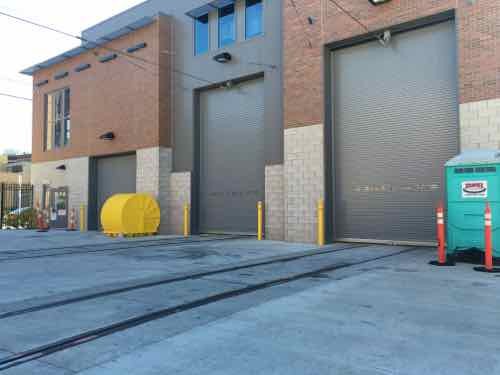
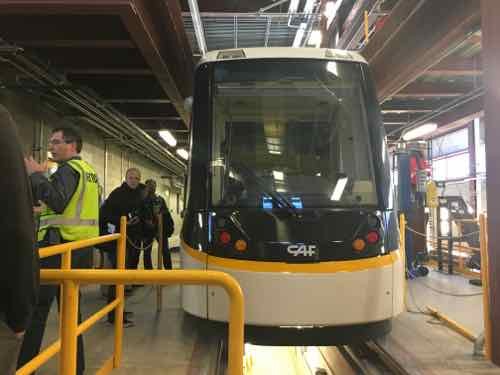
Their streetcar will run north-south on their grid of streets. Where we’ve butchered our grid, theirs remains largely intact, albeit mostly one-way couplets. I traveled over a mile on each of four parallel streets: Elm, Race, Vine, & Walnut. Their rights-of-way are also much narrower than ours are now — they didn’t have someone like our Harland Bartholomew aggressively widening streets by forcibly taking the front bay of buildings.
What we call a trolley or streetcar, Europeans call a tram. Same thing, different name.
The vehicles are CAF Urbos 3, which are 100% low floor. If Cincinnati decides to do a light rail line out to the suburbs in the future they can use the same vehicles. Yes, modern streetcars use the same vehicles as light rail. The difference comes in how the route is designed. Kansas City is using the same vehicle for their streetcar line, which will also open next Fall.
If we do street-running light rail, or a streetcar, these would be in consideration. To meet requirements for federal projects, they have at least 60% US content.
Like most cities, Cincinnati had streetcars in the 19th century, a subway was started but abandoned. Cincinnati hasn’t had rail transit in decades. See their official stteetcar page here.
— Steve Patterson
$100+ million to build, $4+ million per year to operate, and Cincinnati gets a 3.6 mile(!) line . . . http://www.cincinnati.com/story/news/2015/06/05/cincinnati-streetcar-operating-costs/28466521/ . . . https://en.wikipedia.org/wiki/Cincinnati_Streetcar . . . I wonder what the annual operating costs will be on our Loop trolley?
I want to return in late 2017 or 2018 to ride their streetcar, seeing if it has any impact on development, pedestrian levels, etc.
The ability to expand the streetcar and use it the same vehicles for a longer/faster light rail line are important.
Will look at the Loop Trolley tomorrow, operating vintage cars is always more costly than new modern cars.
Cool, glad to see they are doing this, to me though the whole key to success is the rest of the transit system and associated city planning efforts and how they work with this new addition. In other words if redevelopment is not evident it could be the interaction with the rest of the system and not the fault of the streetcar line. For example St. Louis approaches things in a fragmented way that harms the rest, or at least doesn’t contribute.
Just look at the failure of economic development around Metro Stations. Obviously city planners in St Louis didn’t create the conditions for success. That is the test for Cincinnati, whether the rest of the transit system and city work well with this new line in an integrated fashion.
For the same reasons I have mixed feelings about the route of the Loop Trolley.
On a short, 2-3 mile, line, how does a planner “create the conditions for success”? The planners are the dreamers, they don’t create the demand, and they rarely have much power to steer or direct any demand that might be created by any new transit investments (see Steve’s link to Cincinnati’s failed subway). That power lies with the politicians and the private sector (the doers). Unfortunately, many of those doers don’t embrace the same visions, nor do they have the same training in “good” planning, that most public-sector planners have. And you’re right – how well it integrates into the larger bus system will be critical to its long-term success.
Who created demand for expressways to cornfields? Are you arguing that there was a pre-existing demand to go to Chesterfield before Chesterfield existed and that MDOT was simply responding to this demand by building expressways and expressway exits to the area? How bizarre…..
Building freeways (or transit) to places people want to be makes sense. Replacing a bus on rubber tires with a bus that runs on tracks does not make sense, especially when the distances covered are much shorter and the costs are much higher.
So, you DO think that a spontaneous mass movement of people was magically drawn to the cornfields and floodplains of Chesterfield and that MODOT then responded to this demand by building expressways there. Wow….just…wow….
How do you think Kirkwood, Webster Groves and Ferguson got statred? Private investors built streetcars to get their first buyers out to those cornfields. Do you think Chesterfield or St. Chuck would be better sprawl if they were served by rail transit, instead of freeways? Times change, modes of transportation evolve, and at different paces. People, today, have overwhelmingly chosen private motor vehicles as their transportation mode of choice. The government (MODOT) would be INSANE to ignore that reality. Yes, building freeways gave (and continues to give) people a CHOICE, and many (continue to) chose new over old. If we want to change that dynamic, we need to quit blaming MODOT and our fellow citizens for their reasoned choices, we need to give suburbanites reasons to return to the city. And, no, a streetcar that runs a couple of miles won’t do much to attract permanent converts.
The biggest raps I hear against public transit in St. Louis have very little to do with mode and have a whole lot to do with perceptions, perceptions about who rides and about unworkable schedules. The best way Metro could spend $100 million dollars would be to beef up bus service on existing routes, increasing frequency to the point where schedules would no longer be needed. That would help solve two big disincentives, having to wait at bus stops and having to wait (so long) to make transfers. People need to quit having wet dreams over streetcars and focus their energies on (re?)creating a viable, much-improved, bus SYSTEM!
How do you think chesterfield got started? I-64 is how it got started. Chesterfield wouldn’t exist without I-64. If users had to pay for I-64, Chesterfield would be cornfields lining a toll expressway filled with trucks heading for Kansas City. You are missing the forest for the trees.
People don’t want to go somewhere until that somewhere exists. You’re putting the care before the horse.
As matimal points out demand is not the driving force. As an architect you should know that you can design living and social spaces that can be undesirable, hence no demand, or you can design spaces and an architecture that is attractive, hence generating demand.
In the same way the handling of a single transit line, as well as the connectivity to both the physical city and the rest of the transit system can be done in ways to make transit, or other projects succeed or fail.
AS far as planners as dreamers, I have referred to a number of times the book about the creation of the suburbs of Vallingby and Farsta, north and south of Stockholm, by David Pass, MIt Press.
In it planners worked with business enterprises early on to see what works for them to help create capitalistic success.
In fact the capitalist class in St. Louis is mediocre at best. Transit should offer opportunities to make money from the collection of people using transit at various stops. But the capitalists in St. Louis are not interested in customers handed to them on a platter.(major transit stops (Hanley Rd and MLK/Rock Rd station as examples), it is far easier to buy government policy than to actually build something meaningful.
I think it’s more accurate to say that demand had to be created. The demand didn’t spontaneously emerge. How could it? People don’t demand access to cornfields.
not directly related, but sounded like you: http://www.tickld.com/x/wtf-is-wrong-is-wrong-with-americans-this-guy-nails-it
Do you know how much 3.6 miles of interstate cost to build and maintain?
And how many more people use it?!
According to MODOT, it costs $4.6 million per mile to build a new four-lane highway and $180,000 per mile (annually, I assume) to maintain it. For 3.6 miles, that would come out to $165.6 million to build and $650,000 a year to maintain. That would be 65% more than the streetcar, to build, and result in an 83% savings in annual maintenace costs.
The break-even point happens in year 18, where the cumulative higher operating costs of the streetcar exceed the higher construction costs of the freeway . . .and this rough analysis completely ignores the higher number of people who would use the freeway, from day one!
http://www.modot.org/about/documents/MeetMoDOT.pdf
Highways NEVER “break even” in the U.S. They are massively subsidized. Highway users don’t pay a penny to USE highways. They are free. http://www.citylab.com/commute/2015/05/debunking-the-myth-that-only-drivers-pay-for-roads/393134/
The only “break-even” that happens in my analysis is in comparing two crude numbers, the initial, captial costs and the annual maintenance costs. The real question is which is the better expenditure of scarce government funds? The current projections for the Loop Trolley, here, are 2,200-3,600 boardings per day; “the interstate highway system carries nearly 60,000 daily person miles per route mile, 26 times as many person miles per route mile as all other roads (including low usage rural roads), and 22 times as many person miles per route mile as intercity rail (Amtrak) and urban rail combined.” http://www.publicpurpose.com/freeway1.htm . . it all boils down to the most bang for the buck.
I’m not anti-transit, I’m just against wasting limited resources. If Joe Edwards had proposed spending $4 million, annually (what the streetcar is going to cost*), to provide frequent (every five minutes) bus service, between the Loop and the History Museum, I’d be very supportive, especially if it were “free” to the riders. I’d feel the same away about a free, frequent, downtown shuttle bus(es), as well. I just have little patience with spending huge sums on pet projects that promise ancillary improvements, but do little or nothing to improve the overall, regional transit SYSTEM!
The government, using our tax dollars, has no business, nor any real expertise, in trying to pick “winners” (and, by definition, creating “losers”) in the world of PRIVATE development and speculation. If a major private project isn’t “feasible” without a significant public subsidy, it probably shouldn’t be built, at all. Taxes are a burden on existing residents and existing businesses. Using them to line another person’s pockets is immoral, at best. And I don’t blame any of these developers for asking for (or even expecting) government handouts, I lay the blame entirely on our elected “leaders” (and, to a lesser degree, our balkanized county structure). Streetcars, modern or vintage, have a place in this world. Unfortunately, random, short, diconnected, lines isn’t one one of them . . .
*http://www.stltoday.com/business/trolley-revival-rides-on-nostalgia-utility/article_19a93293-77db-570c-b3ac-a720bea8bf14.html
It all boils down to who pays and who benefits. Road spending is contributing to our massive national debt. We are borrowing from the Chinese government and taking the sales taxes paid by poor people who never buy gas to pay for roads. So, your lengthy analysis is beside the point. When government decides where an interstate exit will be it is ‘picking winners.’ That decision gave many millions of dollars of value to some places and deprived others of the same. The PRIVATE property owners of Chesterfield made money by speculating in land that only has value because of PUBLIC spending on I-64. Chesterfield exists because public spending made it possible. You’ve missed the central point here entirely and your comments are baseless.
It seems like JZ somehow is suggesting Cincy should have paid for a four-lane freeway to Whoknowswheresville instead of building up its urban core. That’s nuts.
He seems to be suggesting that people wanted to go to places that didn’t exist yet. That’s insane. Expressways CREATED demand that did not exist previously. He seems to think that expressways were a response to a demand rather than part of a systematic suburban industrial complex intended to create economic demand in the postwar decades. Heads of corporations, the military, and the national government pushed expressways, not ordinary Americans.
Interstate highways were created (and funded with 90% federal dollars) to better connect urban areas; suburban sprawl was an unintended consequence.
So you agree that interstates were NOT built in response to demand to go to suburbs that didn’t exist. Interstates were RATIONALIZED by the elite that saw them as a chance to make money as a way to connect urban areas. They were really built to create access to new land that could be bought and sold for a nice profit and built on for an even bigger profit. There was no grass roots demand for the suburban industrial complex. It was foisted on America by the elite. It was not in response to demand.
“As one of the components of the National Highway System, Interstate Highways improve the mobility of military troops to and from airports, seaports, rail terminals, and other military bases. Interstate Highways also connect to other roads that are a part of the Strategic Highway Network, a system of roads identified as critical to the U.S. Department of Defense. The system has also been used to facilitate evacuations in the face of hurricanes and other natural disasters.”
https://en.wikipedia.org/wiki/Interstate_Highway_System
“The political economy of the Cold War defense complex laid the foundations for the latter-day patterns of high-tech suburbanization in a number of ways.” p. 60 The New Suburban History by Thomas Sugrue
No, I’m stating that investing the same money in better bus service would deliver better service to far more real users.
You can’t know that anymore than interstate builders could have known how many would use their highways and how many would build their financial lives on them.
Yes I can. I spent 5 years serving on a public transit board (Denver’s RTD), and could see direct results, both positive and negative, from every action the agency took. I’m also very familiar with the financial side of providing public transit services. The fundamental problem with both current streetcar proposals/project in St. Louis (along with the Northside-Southside Connector study) is that they only propose replacing existing buses with new rail vehicles, without significantly increasing the frequency of service nor the number of seats offered, but/yet at a higher cost of providing comparable bus service.
The mantra on streetcars is that more people will choose to ride, because rail, and more investment will occur, because rail. My experience is that more people will choose to ride, anything, when a) they need to pay (more) for parking, b) their monthly pass is subsidized, either by their employer or by their school, c) service/schedules don’t suck / take 2-3-4 times longer than it takes to just drive, and d) the system is conceived as (and designed to function as) an integrated SYSTEM, using a variety of technologies / vehicles and minimizing the “pain” and inherent hassles associated with transferring. And when it comes to driving private investment, there’s little evidence that that has happened around most of our current Metrolink stations!
The new Loop streetcar line does none of that. Free parking will remain on the lots to the north. Fares apparently will not be integrated into Metro’s and have yet to be disclosed (including any discounted pass programs). Hours of operation and coordination with Metrolink schedules remain undetermined. And all will be “adjusted” after the new wears off and fares fail to meet projections . . .
There’s a reason why streetcars went away in the ’40’s and ’50’s – buses had improved (better tires, better diesel engines) while streetcar development had stagnated. Buses were always cheaper (and more flexible), but they weren’t very reliable. Once that changed, after WW II, there was little reason to keep them on city streets, while there were more reasons to keep the interurban lines, with their dedicated rights-of-way, in operation. (That’s also the rationale for continued investments in “light rail”/Metrolink and BRT.) As long as streetcars operate in mixed urban traffic, and make frequent stops, they will be no better than buses in delivering seats to riders. And, unfortunately, it does all get back to $$$$$$. You can’t have both more service AND more-expensive service, you have to pick one or the other (and I’ll pick more service, any day).
RTD Board — elected without opposition http://extras.denverpost.com/opinion/edits1006c.htm
Yeah, so? Would you rather have an appointed board, like we have here?! I was appointed to fill a vacancy and had to run for a full 4-year term, a year later. It was (and remains) a non-partisan election, anyone can run, if they can collect 250 valid signatures. At least I won my race . . .
Serving on a board, any board, gives you way more insight into how something operates than watching from the outside, relying on media reports or sitting in the peanut gallery. With an elected board, the board member is responsible to the electorate and not just to whomever appointed him/her (the governor, in the case of Metro’s board). And with term limits, there will always be turnover.
No you can’t. You’re assertion that increasing the number of bus seats moving around St. Louis would increase the use of buses, because buses, is just an assertion. You can’t prove it. You’re prediction may very well be wrong. I simply don’t believe that lack of capacity is why people don’t ride buses. You CAN’T predict what effects transportation choices will have. It is your beliefs or ideology that lead you to favor “more service,” not some objective provable ‘fact.’
You’re describing looking backward at transportation decisions after the fact. I’m describing prediction of the future. You act as if transportation decisions happen in vacuums and have a one way cause and effect relationship. The decisions of a single transportation authority are not solely responsible for the success or failure of the decisions that transportation authority makes. There are things entirely beyond the control of a transportation organization that nonetheless explain the fortunes of that organization’s efforts.
Neither of us can “prove” anything until it is built, operational, tested and analyzed . . . and that data will change over time, as externalities change. I don’t disagree that streetcars are kinda cool. I just can’t find a rational economic justification for a higher taxpayer subsidy for this mode than the current taxpayer subsidy for general metro service: “How will trolley operations be funded? Taxes collected by the Loop Trolley TDD and rider fares will fund operations.” http://www.looptrolley.com/faq/
At last, something we can agree on….transportation in America is not built, operated, or analyzed in a systematic way. Until the colossal taxpayers subsidies of roads end, it really doesn’t matter what operators of buses, streetcars, or any other form of transportation do. You’re describing rounding errors in transportation use and spending in St. Louis. Increases in the number of empty busses pounding along St. Louis’ boulevards don’t matter. Streetcars are best understood as a demonstration project meant to see how people respond. It’s one little thing local government can do while the state of Missouri works hard against the interests of cities. Streetcars aren’t your enemy, the Missouri highway industrial complex is.
And my concern is that the Loop Trolley is a horrible “demonstration project”. If it fails (as it likely will) it will set back further investments in rail transit, for decades!
No one ever bothered to come up with an actual, as opposed to a rhetorical, “rational economic justification” for interstates. It just didnt’ happen. Why would you apply something to streetcars that was never applied to expressways? Subsidies of streetcars are an almost immeasurable small number in comparison to road spending in St. Louis. It’s like worrying about spending too much money on the door bell for a $20 million mansion.
In a world with many economic variables, the larger and more permanent the infrastructure investment, the more it encourages private investment. But stops don’t attract investment because they represent virtually no public expenditure while expressway exits do attract investments because they represent massive public expenditure and can’t be easily replicated. The owner of land next to an expressway exit invests because he is more confident that his land will continue to enjoy superior access because of the sheer cost of building it.
You keep wanting to compare freeways and streetcars, while I (and everyone else involved in public transit budgeting) want to compare streetcars and buses.
The correct comparison is of ALL transportation. It all involves money and all money counts equally. Artificially refusing to acknowledge where 90 percent of all transportation money is spent in a discussion of transportation is absurd.
It might be the correct comparison, intelectually, but they’ve been (and continue to be) funded from two distinct pots of money, and usually with different governing bodies in charge of those expenditures! Yes, more money should be dedicated to public transit, but expecting it to come from cutting what “90 percent” want and use is a non-starter, politically.
Changes in transportation funding are happening as we speak.
http://interlochenpublicradio.org/post/higher-gas-taxes-registration-fees-part-new-roads-deal.
There are many other such links but this site won’t allow me to post them.
Actually freeways and hence the automobile should be involved in any discussion. That is a central part of the problem now, automobiles are treated as untouchable and any crumbs of funding available is then designated to mass transit.
A major reason that the auto should be included is that there are many hidden costs, from pollution, to global warming, oil wars and military intervention, health and of course the huge tax credits given to oil companies.
All of this indicates that automobile dominant solutions as practiced in St. Louis are short sighted and eventually destructive.
Are bus only systems better than those that include streetcars and rail? Maybe, but it remains to be seen and certainly nothing has been proposed that include all elements of transit, including pedestrian and bicycles in a unified system, linking and placing all transit elements on an equal footing with the automobile.
Beyond that what are we going to do? Continue to plunder and butcher the earth in order to supply everyone in the world with automobiles over and over, for centuries?
The automobile is not sustainable in any world of engineering or human logic.
In short it is important to be careful of the world of budgeting, the true questions that are left unasked become buried under imagined movements of money. Money, yet another creation of man just like the auto, rail and streetcar.
I agree, “lack of capacity is [not] why people don’t ride buses” in the St. Louis region. The four big reasons are that buses, here, are viewed as something poor, primarily African-American, people (are forced to) use, the schedules suck (it takes 2-3-4 times longer than it takes to drive), the combination of our weather (hot, cold, wet, windy) and minimal, if any, bus stop infrastructure means waiting for a bus sucks, and suburban bus service (where an increasing number of jobs are located) sucks!
If there was a “SYSTEM” involved in expressways, it was providing access to land owned by powerful key land owners, not a broad variety of ordinary Americans. Historians have chronicled how expressway routes were decided on cocktail napkins at party political fundraisers, not by professional planners. IF you think you see a “system” in them, you are mistaken.
Much like Amtrak? And yes, on the micro level, when it came to locating interchanges and exact alignments, political favoritism definitely came into play – no differently than rail transit alignments – see Joe Edwards and the alignment of the Loop Trolley!
It was NOT just on a micro level.
JZ71 — the fact that you uncritically quote Wendell Cox (a known liar who makes up fake numbers) kind of damages your credibility. You clearly aren’t yet critical enough to tell reality from propaganda.
In future, please learn to tell reality from propaganda. I’m not gonna argue with the principle that people will ride more when they pay for parking, people certainly care about service & schedules that don’t suck, and people care about an integrated system. I’m not even going to defend the Loop Trolley, which is poorly designed. But fergodssake you should do some basic research on your sources before you thoughtlessly cite Wendell Cox!
And you keep digging up the conspiracy theories from 6 decades ago. The world has changed – what was the best answer 100 years ago is rarely the best answer today. Are you ready to give up your cell phone and go back to the telegraph? Give up air conditioning and go back to open windows and just fans?
Transit numbers are like every other statistic – they get manipulated to document desired outcomes. And I kinda understand why rail geeks love rail – it generally is a nicer ride than on a bus. But I spent too many years dealing with limited budgets, limited service and unhappy users to ignore the higher costs rail brings to the table. For me, the most important component of any transit system is the number of seats; what they’re wrapped in is of far less importance.
And yeah, I know that Wendell Cox has an agenda, just like streetcar advocates have an agenda, the disabled community has an agenda, you have an agenda and I have an agenda – if you don’t have an agenda, you simply don’t care!
I’m stating that you can’t know that beforehand.
Yes, everything is an educated guess. However, if a new bus route fails to meet expectations, the vehicles can easily be deployed elsewhere and any investments in bus stops (other than concrete pads) can be relocated fairly easily. If a new streetcar line fails to meet expectations, the vehicles are much harder to redeploy and the track is impossible to move (although the track and overhead lines can be ripped out and recycled for pennies on the dollar).
You’ve got the cause and effect relationship backwards. If people realize that a new bus service may quickly be ended, they aren’t going to bother to invest in a life that can take advantage of that bus service. Expressways have sparked development BECAUSE they can’t be moved and BECAUSE they can be assumed to continue to provide superior access to places that aren’t near expressway exits for many years, and BECAUSE they are expensive and can’t be easily replicated somewhere else. Its who pays and who benefits that matters. An ‘objective’ systematic analysis of what is the ‘best’ transportation ‘system’ is impossible. It’s intellectual hubris to think that it is.
And this is where we differ. You view public transit (streetcars) as primarily a development tool (with transportation playing second fiddle). I view public transit (in all forms) as primarily a transportation tool (with development playing second fiddle).
And I’ll repeat, public transit works best when it’s an integrated system, not a collection of random parts. Yes, streetcars imply permanence, but few people have either the luxury or the interest in using just one route. Most people have multiple destinations in their lives, and there no guarantees that your workstation (or apartment) will be in the same location next month or next year, as it is today! A successful bus route ain’t going away any quicker than a streetcar line – I’m hearing NO one worrying about the Grand line going away!
Transit properties’ primary role is providing subsidized transportation to those who choose to use it, not to pick winners in the development game. Transit properties are always chasing demands from riders for more service, leaving very little extra money to gamble on random private developments – that’s what TIF districts are for! And if demand falls on any route, there are plenty of places (with more demand) that deserve to receive more service . . .
ALL transportation spending is primarily a development tool.
Transportation without a developed destination is just wandering aimlessly.
It’s not an economically significant activity. Many people have NO
“workstation” today. They work wherever they are. They can be where
they want…or where they can get most easily and cheaply. This makes big,
expensive, immobile, and inflexible expressways real transportation dinosaurs.
I don’t know what “transit properties” are or how they could possibly
be any different from other properties (I doubt that they are) but road use
today is massively subsidized. Were that to end, the entire discussion of
buses, streetcars, and any other form of transportation would be radically
different. Again, people don’t want to go somewhere until they are aware that
there is a somewhere to go. And there is only a somewhere to go when
transportation is created to allow people to get there to make some sort of
there…there. No one will ever invest in anything based on a bus route, but
they WILL invest based on a streetcar route. Imagined ‘systems’ or ‘efficiencies’
are beside the point. They’ve never been applied to any other form of
transportation in America and therefore shouldn’t be applied to streetcars.
Change one word and the same argument applies: “This makes big, expensive, immobile, and inflexible” streetcars “real transportation dinosaurs.”
Transit properties is a term of art – Metro / Bi-State is a transit property. St. Clair County Transit is a transit property. OATS is a transit property. CTA (Chicago Transit Authority) is a transit property.
Irony and sarcasm are dead, I guess. I wasn’t trying to undermine my argument that expressways attract development BECAUSE they are expensive and permanent. I was reminding you that investment matters. “Transit properties” are not “properties”, they are organizations. Property is ownership and these organizations aren’t important because of what they own, but because of what they do.
“Transit properties” is the term used within the industry (and likely a legacy left over from when public transit was built and operated by private companies, companies that paid concession fees to cities for their use of the public right-of-way). If you prefer, we can call them transit agencies or transit systems or transit collectives – whatever floats your boat.
I agree, “No one will ever invest in anything based on a bus route” – simply because most people continue to choose to drive. If they do choose to “invest based on a streetcar route”, it’s their choice. A streetcar does not guarantee success, but it MAY attract more consumers of/to whatever they’re investing in. The real question is who should be paying to enhance that private investment? The general public (through taxes) or the developer (thrpugh his or her private funding resources)?
I’ll repeat, there are not enough tax dollars to go around to fund every “good idea” or “good thing” that government “should” be doing. You want to use streetcars as a development tool and a social engineering tool. I want to use streetcars as one part of an integrated public transit system. We both want to spend money on the same thing, just not for the same reasons or in the same place(s).
One (or both) of us needs to convince everyone else to spend money on something that THEY may or may not want or see a need for. You probably won’t change my opinions, and I probably won’t change yours, but if we work toward a common goal, something might actually happen. Proving someone wrong is not the answer, building consensus is!
It’s a misleading and wrong-headed use of the term property. I’ll repeat there aren’t enough tax dollars to even maintain the roads we have. People will be more and more open to new funding arrangements as this becomes more and more clear. Convincing “everyone else to spend money on something that THEY may or may not want or see a need for” is the best description of the creation of U.S. interstates I’ve ever read. If it worked for interstates, why not for streetcars?
I’m sorry that you find the term “misleading and wrong-headed”. However, every industry has unique terms, words and phrases that make litlle sense to outsiders. For instance, in the St. Louis Polce Department, a “cruiser” is what most civilians would call a paddy wagon, the van that transports prisoners to jail. In the gaming industry, what most guests call “chips” are really “cheques”. You can either try and change things or accept them the way they are (pick your battles).
As far as “convincing everyone else”, yes, it COULD work for streetcars, as well, here in St. Louis. The trick will be getting the FIRST project, the local “demonstration” project, RIGHT! I’m not that familiar with Cincinnati, and I know very little about their new streetcar line, so I have no clue if it will be “successful”, or not. I do have serious reservations about Joe Edward’s tourist attraction and how it will (negatively) impact the future of rail transit in St. Louis. I’ve already stated why I believe it will not meet its rosy projections, and it WILL be what everyone we’re trying to “convince” will envision when we/Metro/our elected officials decide to go to the voters to ask for more money to build more streetcar lines . . .
*http://onlinepubs.trb.org/onlinepubs/tcrp/tcrp_webdoc_43.pdf
Orwellian reinvention of language is a problem, not a solution. It confuses instead of clarifying. Grimly accepting that everything will remain as it is now forever is not the answer either.
It’s almost civic negligence for recovering cities like Cincy and Saint Louis not to put a streetcar (or at least superior BRT) down the prime redevelopment core.
What a better expenditure of Chinese bond sales or of the sales taxes paid by little old ladies who don’t drive?
The main thing you are missing JZ is that government already picks winners or losers with public policy. The underlying problem is that the winners are the ones who purchase government wholesale.
It is by no means a natural state of affairs that the automobile, choking roads and spewing pollution is dominant. It has taken policy decisions to make it the status quo.
Nor is automobile dominance come from demand, it comes from myriad policy decisions, largely influenced by those with most to gain
As I said elsewhere the capitalists in St. Louis are mediocre at best, unwilling to undertake any risk even where success is all but guaranteed
We know the corruption goes back to the 50’s and early 60’s when Standard Oil, Firestone, General Motors collaborated to buy out streetcar lines across the nation and shut them down, including St. Louis.
They knew what they were doing and we live with the results today.
It is well past time to balance the auto with all forms of movement, starting with and most importantly including the pedestrian.
The St Louis region is an urban planning nightmare with its lust for oil related money.
The truth is if the Koch Brothers style capitalists were as dominant in the past as they are today we would still be using buggy whips.
Major changes need to occur in people movement, the automobile by itself is not a solution. And if we want to talk about costs we should include pollution, climate change, natural resource destruction and the health and welfare of people, then the auto fares much worse.
The role of the automobile in society needs to be rethought. The only people blocking these efforts are the buggy whip people, the capitalists who control everything including government. It is not a free market of private development, the winners and losers are already picked. That is why the middle class keeps losing ground despite productivity gains and why mass transit in St. Louis does not truly work.
I already said that government picks wnners and losers . . . and that is wrong: “The government, using our tax dollars, has no business, nor any real expertise, in trying to pick “winners” (and, by definition, creating “losers”) in the world of PRIVATE development and speculation. If a major private project isn’t “feasible” without a significant public subsidy, it probably shouldn’t be built, at all. Taxes are a burden on existing residents and existing businesses. Using them to line another person’s pockets is immoral, at best. And I don’t blame any of these developers for asking for (or even expecting) government handouts, I lay the blame entirely on our elected “leaders” (and, to a lesser degree, our balkanized county structure).”
The challenge facing the advocates of streetcars is that they’re a small minority of taxpayers compared to the vast majority of voters who continue to advocate for more and better highways. And as long as advocates for better transit concede defeat (“why mass transit in St. Louis does not truly work”), the cycle will continue. Mass transit does not need to look like transit from 50 or 100 years ago to be successful (when success is defined as moving people and attracting new riders). Transit “in St. Louis does not truly work” because it’s a) spread too thinly, and b) the focus remains on building the next, expensive, rail project and not on creating a viable, compact bus SYSTEM with frequent service and good connections!
PRIVATE development is in reality the purchase of government. According to your logic we should not even have roads since they are not “feasible” without government subsidy. But all of a sudden it’s bad to support transit.
The demand is created by the viability of the system, you narrow it to a bus system, completely ignoring the value of other means of movement, including pedestrian. Do you think the many, many cities across the globe that include streetcars, subways, light and heavy rail are doing so because of nostalgia?
The minority you so deride is created by government policy, of course no one is going to use a half ass transit system like St. Louis.
The fact is around the world successful transit systems use all methods of transit to create viable systems in different combinations. So in Seoul South Korea it is an extensive subway system with an extensive bus system for example.
Bad design is what we have now in St. Louis, the transit system is not inherently defective, nor is a good solution likely to include buses only because of “economics”. In fact a multi layered system for St. Louis that includes subway lines as well as streetcars along with light and heavy rail and buses may be the best solution.
The art of the transit system and the art of the surrounding city determines success, not doing the cheapest thing possible at every turn as a means of decision making.
And please, the public subsidy of the automobile is off the charts. (ie, billions in tax breaks to oil producers and so on)
Umm, no . . . private development is primarily a transaction between private individuals – individual consumers buy or rent a product or a service from a provider. It can be a single-family home, a loft apartment, a pork chop, a beer and a shot, a wedding dress or the services of an attorney. Government comes “along for the ride” by trying to tax / get a cut of every transaction, so it can deliver “services” to its constituents. And yes, some (many?) of the “services” government provides are desired by most taxpayers – roads, highways, snow removal, police, fire protection, trash collection, jails, prisons and parks, to name a few. Where the contract with taxpayers starts to unravel is when “services” start to be viewed as either “too expensive” or too “irrelevent” for government to be providing. Occupancy inspections, public transit, public libraries, public baths*, bloated un-funded public employee pension liabilities, double-dipping public employees and professional football stadiums are all things a lot of voters could do without.
When it comes to transit, especially in St. Louis, my focus on fixing and growing the bus system is a reflection on the inadequacies of the entire system. The region does not embrace public transit, and the funding reflects it. With too few resources, it makes absolutely no sense, now, to be building streetcar lines that are not integrated into a larger system, especially when there is no plan to create and fund a comprehensive SYSTEM! Metro needs to provide as much service as possible for as little as possible, on a per-rider and per-mile basis. And while urbanists are quick to dismiss the suburbs as unservicable, and thus “undeserving” of public transit, that attitude is hugely counter-productive, since the suburbs generate a huge amount of taxes (that can be directed to supporting public transit) and they’re home to many of the jobs urban residents want to get to! You may not like how the suburbs look and how they function, but the suburbs ARE, by definition, a part of any urban region. Ignore them at your peril – they control the purse strings!
My biggest fear, when it comes to local transit, is that continued spending on random rail projects, that come in over budget and attract fewer riders than projected, will continue the cycle of “who needs transit?” and “why are we spending so much?” on it. I’m pretty sure that the Loop Trolley will turn out to be a minor tourist attraction and spur the development of a few new projects along the eastern half of its route, but it will also end up being a huge money pit and will do absolutely nothing to enhance Metro’s larger system, nor attract more riders to use transit – it will be another local example of a large amount of public money poorly spent. The streetcar lovers will love it and anti-transit people will focus on the numbers, just like they did with Blue Line. If we want to see a north-south line happen, as a rail line (or even as a BRT line), we better hope that I’m way too pessimistic about the Loop Trolley. Transit funding, and thus, transit itself, relies on building a consensus, of providing services to as many people as possible . . . and, in St. Louis, the two current streetcar projects simply won’t do that!
*http://nextstl.com/2012/12/the-history-of-the-st-louis-municipal-bath-house/
It is IMPOSSIBLE for government to act in ways that do not favor some over others. You imagine a systematic nature to transportation planning and funding in the U.S. that has never existed and quite frankly can’t exist.
True (to your first statement). False (to your second). And if you truly do agree that transportation investments should be random (as a direct result of NOT having “a systematic nature to transportation planning and funding”), then St. Louis will remain cursed with both a public transit infrastructure that is inefficient, disconnected and an increasing waste of money!
Indianapolis: http://www.indyconnect.org/pages/Plan-The-Plan/
Denver: https://en.wikipedia.org/wiki/FasTracks
Kansas City: http://www.kcata.org/light_rail_max
Houston: http://www.h-gac.com/taq/plan/2035_rtp.aspx
Austin: http://www.capmetro.org/uploadedFiles/Capmetroorg/Future_Plans/Strategic-Plan_Presentation-2014-2019.pdf
and St. Louis: http://metrostlouis.org/MovingTransitForward.aspx
The location of interstates in America IS random whether I like it or not. St. Louis’ problem is that its INTERSTATES have not had a “systematic nature.” You’re confusing the appearance of unity and the power of postwar rhetoric from the suburban industrial complex with an actual “systemic nature.” That is an illusion. Decisions about interstates were made in smoky rooms where local politicians traded votes and leveraged their access to key landowners who stood to benefit from locational decisions.
Government has always picked winners and losers and always will. If you don’t agree, please return your land to the Native Americans who government stole it from.
It’s fine to argue about what we should spend our collective government efforts on. But arguments like “government shouldn’t pick winners or losers” are vacuous.
By the way, you should know you’re citing a liar. “Publicpurpose.com” is Wendell Cox’s personal anti-rail hackjob website. It’s not a legitimate organization. He lies.
Yes, he has an agenda. He also makes some valid points, even if he is cherry-picking his data . . . no differently than ANY other person who has a position they want to support or push . . .
Matimal, the exception is toll roads like we have in the east. 🙂 Some of the toll roads actually do pay for themselves. I’m all for toll roads.
I can’t say which I prefer; streetcar or Cleveland level (or better) BRT (I think it depends on how much more coverage we could get with the less expensive BRT) but we need to get something down the Saint Louis Streetcar route and then some.
This has only taken Cincy infinity years of hard infighting, to get a really minimalistic system.
It’ll do OK; it’s not a great route but it’s an OK route. It’ll spur future expansion. Think of it as the foot in the door. The anti-rail forces fight very hard to make sure that there’s NO rail service so that people won’t even consider it; they succeeded in Columbus, but not in Cincy.